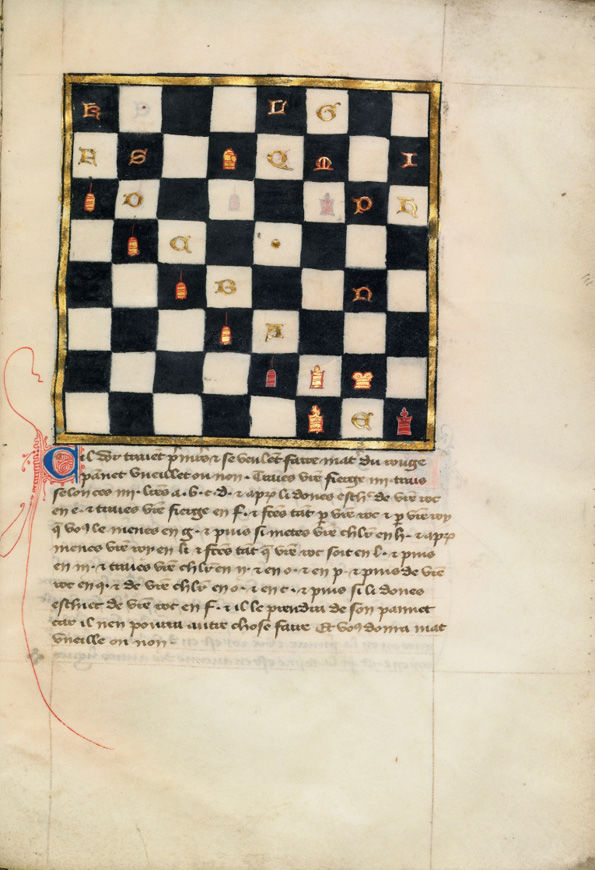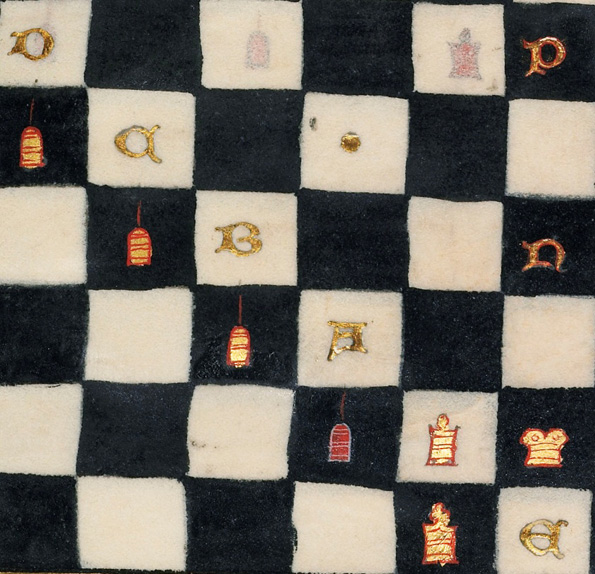I recently visited the Cloisters to see The Game of Kings with curator Barbara Drake Boehm. I had always admired the Lewis Chessmen and was delighted to see them up close. The clever way in which the pieces are displayed on modern reconstructions of black-and-white chessboards reminded me of a manuscript of chess problems found in the collections of the J. Paul Getty Museum.
Chess Problem, Bonus Socius, northern France, late 1300s. Ink, tempera colors, and gold leaf on parchment. J. Paul Getty Museum, Los Angeles, Ms. Ludwig XV 15, fol. 97
The manuscript is known as Bonus Socius, Latin for "good companion," as the author identifies himself in the prologue to a Latin copy of the manuscript. Although the Getty manuscript lacks the prologue, we know the text from other manuscripts: "I, a good companion falling in with the wishes of my companions, have taken the trouble to collect into a book all the problems which I have discovered in chess." Another copy identifies the author as Nicholas de Saint-Nicholai, from Lombardy (Italy). The book is considered the oldest compilation of chess problems from medieval Europe, and is thought to have been written in the second half of the thirteenth century. The Getty's copy dates from the late 1300s, about a hundred years after the original, and is written in French, perhaps made for a nobleman whose Latin was not quite fluent. A number of copies in French can be dated to this time period and, based on the dialect, they—including the Getty's copy—can be localized to the north of France.
The Getty manuscript of the Bonus Socius is arranged as a series of 204 chess problems on facing pages. Each one includes a diagram and explanatory text that considers a particular arrangement of pieces leading to an end game. The golden pieces move first to checkmate the red opponent in a series of two to fifteen moves. In this example, you can see that the author has assigned letters of the alphabet to the sequence of moves:
Chess Problem, Bonus Socius, northern France, late 1300s. Ink, tempera colors, and gold leaf on parchment. J. Paul Getty Museum, Los Angeles, Ms. Ludwig XV 15, fol. 97 (detail)
In the Middle Ages, chess was not only a game of skill and intellect, it was also a game on which competitive bets were wagered (for more on this, see "An Epic Battle"). The players (and spectators, no doubt) bet on both who would win the game and the number of moves it would take. A book of chess problems could therefore serve not only as a teaching tool but also as a guide to gambling.
The individual pieces depicted in the Getty's manuscript have more in common with modern chess sets than the lively characters seen in the Lewis Chessmen, but the manuscript does share the pieces' Scottish past. The Lewis Chessmen were found on the Isle of Lewis in 1831 [see "The Heather Isle" (Eilean an Fhraoich)]. The Getty manuscript was owned by Sir George Douglas of Kelso, in the south of Scotland, in the beginning of the nineteenth century. Douglas died in 1821, just ten years before the discovery of the chessmen on a desolate beach far to the north. For the moment, the Lewis Chessmen on view at The Cloisters and the Bonus Socius manuscript are reunited in one country, good companions on the east and west coasts.
For more on Bonus Socius, see James Magee's Good Companion (Bonus Socius): Thirteenth-Century Manuscript Collection of Chess Problems (Florence, 1910); and Meindert Niemeijer's Bonus socius: Bijdragen tot de cultuurgeschiedenis van het schaakspel en andere bordspelen (The Hague, 1977).

